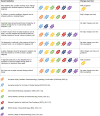Current guidelines for the management of celiac disease: A systematic review with comparative analysis
- PMID: 35125825
- PMCID: PMC8793016
- DOI: 10.3748/wjg.v28.i1.154
Current guidelines for the management of celiac disease: A systematic review with comparative analysis
Abstract
Background: Wheat and other gluten-containing grains are widely consumed, providing approximately 50% of the caloric intake in both industrialised and developing countries. The widespread diffusion of gluten-containing diets has rapidly led to a sharp increase in celiac disease prevalence. This condition was thought to be very rare outside Europe and relatively ignored by health professionals and the global media. However, in recent years, the discovery of important diagnostic and pathogenic milestones has led to the emergence of celiac disease (CD) from obscurity to global prominence. These modifications have prompted experts worldwide to identify effective strategies for the diagnosis and follow-up of CD. Different scientific societies, mainly from Europe and America, have proposed guidelines based on CD's most recent evidence.
Aim: To identify the most recent scientific guidelines on CD, aiming to find and critically analyse the main differences.
Methods: We performed a database search on PubMed selecting papers published between January 2010 and January 2021 in the English language. PubMed was lastly accessed on 1 March 2021.
Results: We distinguished guidelines from 7 different scientific societies whose reputation is worldwide recognized and representative of the clinical practice in different geographical regions. Differences were noted in the possibility of a no-biopsy diagnosis, HLA testing, follow-up protocols, and procedures.
Conclusion: We found a relatively high concordance between the guidelines for CD. Important modifications have occurred in the last years, especially about the possibility of a no-biopsy diagnosis in children. Other modifications are expected in the next future and will probably involve the extension of the non-invasive diagnosis to the adult population and the follow-up modalities.
Keywords: Celiac disease; Clinical guidelines; Genetics; Gluten; Gluten sensitivity; Gluten-free diet; Histopathological findings; Non-invasive diagnosis; Serological markers.
©The Author(s) 2022. Published by Baishideng Publishing Group Inc. All rights reserved.
Conflict of interest statement
Conflict-of-interest statement: The authors declare that they have no conflict of interest.
Figures











References
-
- Fasano A, Catassi C. Clinical practice. Celiac disease. N Engl J Med. 2012;367:2419–2426. - PubMed
-
- Whitburn J, Rao SR, Paul SP, Sandhu BK. Diagnosis of celiac disease is being missed in over 80% of children particularly in those from socioeconomically deprived backgrounds. Eur J Pediatr. 2021;180:1941–1946. - PubMed
Publication types
MeSH terms
Substances
LinkOut - more resources
Full Text Sources
Medical
Research Materials

